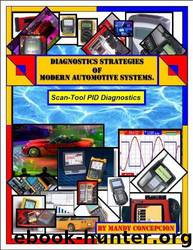Automotive Scan Tool PID DIagnostics (Diagnostic Strategies of Modern Automotive Systems Book 6) by Concepcion Mandy

Author:Concepcion, Mandy [Concepcion, Mandy]
Language: eng
Format: epub
Publisher: www.autodiagnosticsandpublishing.com
Published: 2011-05-28T16:00:00+00:00
Fig 6 – This chart shows the relation between EGR flow and fuel trims. In this case, bank 2 EGR ports were clogged causing all the EGR gasses to flow to bank 1, hence the misfire on cylinder # 3 & 1.
Notice the LTFT on bank 1 at 0.00% as compared to 15.00% for bank 2 while pre-loading the engine, indicating the ECM reducing pulsation for bank 1. The excessive EGR flow is causing the ECM to reduce injector pulse (to bank 1), since it interprets the inert exhaust gasses as a rich condition. Bank 2, although clogged, is being overly compensated with a wider injector pulse. This is a normal reaction by the ECM to the high load condition and EGR operation. The difference here is that there are no EGR gasses flowing to bank 2.
Wider inj. pulse to bank 2, due to pre-loading of the engine and EGR compensation. However, there are no EGR gasses present.
Excessive EGR flow can also cause the MAP sensor output voltage to go too high (speed/density) and fool the ECM into sensing a bigger load placed on the engine. This will cause the ECM to increase injector pulse, in order to richen the mixture and compensate for the bigger load.
Download
This site does not store any files on its server. We only index and link to content provided by other sites. Please contact the content providers to delete copyright contents if any and email us, we'll remove relevant links or contents immediately.
| Automotive | Aviation |
| History | Mass Transit |
| Owner's Manuals & Maintenance Guides | Railroads |
| Reference | Ships |
Small Unmanned Fixed-wing Aircraft Design by Andrew J. Keane Andras Sobester James P. Scanlan & András Sóbester & James P. Scanlan(32683)
Navigation and Map Reading by K Andrew(4960)
Endurance: Shackleton's Incredible Voyage by Alfred Lansing(4626)
And the Band Played On by Randy Shilts(2078)
Wild Ride by Adam Lashinsky(1898)
The Box by Marc Levinson(1894)
Top 10 Prague (EYEWITNESS TOP 10 TRAVEL GUIDES) by DK(1892)
The Race for Hitler's X-Planes: Britain's 1945 Mission to Capture Secret Luftwaffe Technology by John Christopher(1765)
The One Percenter Encyclopedia by Bill Hayes(1752)
Trans-Siberian Railway by Lonely Planet(1663)
Girls Auto Clinic Glove Box Guide by Patrice Banks(1653)
Looking for a Ship by John McPhee(1606)
Batavia's Graveyard by Mike Dash(1581)
TWA 800 by Jack Cashill(1562)
Fighting Hitler's Jets: The Extraordinary Story of the American Airmen Who Beat the Luftwaffe and Defeated Nazi Germany by Robert F. Dorr(1544)
Good with Words by Patrick Barry(1539)
Troubleshooting and Repair of Diesel Engines by Paul Dempsey(1528)
Ticket to Ride by Tom Chesshyre(1520)
Bligh by Rob Mundle(1516)
